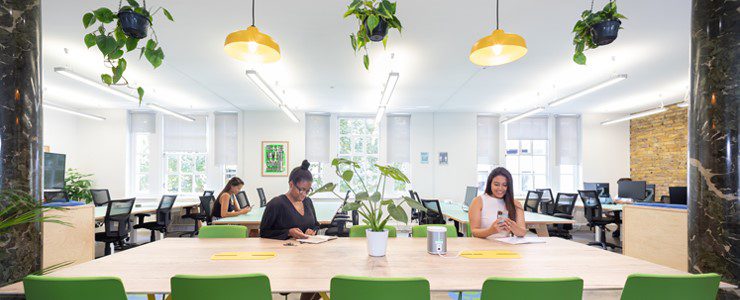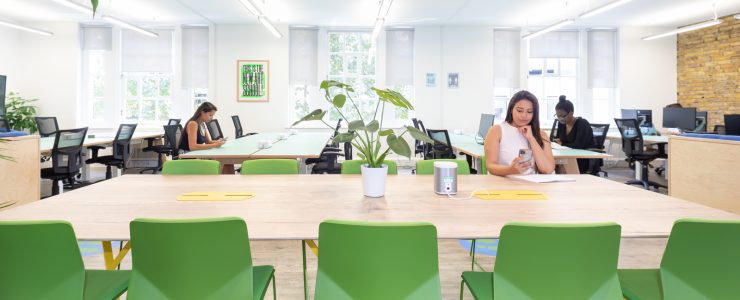
Biophilic design: Bringing nature to the office
Increasingly the trend of biophilic design in offices is sweeping the corporate world. The idea is to create an area of calm and tranquility in the workplace, helping employees to connect with nature, and it has untold health benefits.
Biophilia means a love of living things and supporters believe the human race is innately drawn towards certain natural habitats to keep us stress-free. It literally means “love for nature” in Latin.
If we’re deprived of this natural environment by sitting in an office all day, we will feel more stressed, because this is going against our natural instincts.
While it’s not feasible to work outdoors, we can bring nature into our office with the clever use of plants, which provide joy and refuge from the intensity of our regular day.
What is biophilic design?
Biophilic design is described as creating a “pocket of refuge and tranquility”, with the colour green playing an important role. This is because being in a naturally green environment, such as a park, makes people feel more relaxed. We always associate green with the natural world, growth, vibrancy and ultimately a sense of wellbeing.
The question is how to bring this feeling to an office in the middle of an urban area. The solution is to create your own park view, using indoor plants, so that even in the middle of November, some cacti and succulents can create a green haven.
Best plants for biophilia
While all greenery is useful to promote wellbeing, research has shown some plants work better than others. Experts tell us interacting with plants is far better than just looking at them in a passive way.
For example, practicing mindfulness training with plants, polishing their leaves and re-potting them, is of benefit, as is watching their progress and recording new signs of growth. Being interactive works better than simply surrounding yourself with static plants – although even this is better than having no plants at all.
Choose green plants that change over time, such as flowering seasonally, or a species that grows quickly, so you can continually see new leaves, or blooms forming.
Design your flexible workspace
While people have been working from home during the Covid-19 pandemic, they may have got accustomed to being surrounded by house plants.
If you’re returning to a flexible office, such as a coworking space, it’s simple to take your bit of nature back to work.
Don’t give yourself a culture shock by losing your natural environment: set up your corner as a green haven that everyone will enjoy.
Keep a few useful hand tools in a drawer so you can carry out bits of plant maintenance when the need arises. If you’re feeling stressed, taking time out to re-pot a plant, or add some liquid fertiliser, can provide a welcome break to restore calm.
Keep a few plants together, making sure they are well cared for and have plenty of light. Associate this space with vibrancy to uplift your mood. Make sure your workspace is comfortable and well laid out and then build the plants around it.
How do you create different moods?
The type of plants you use can make a statement. For example, if you want your reception or breakout areas to look vibrant and lively, organise the furniture in such a way as to promote collaboration, such as having some comfy sofas facing into the centre. Then, add something like large Kentia palms, creating a canopy over the low seating area.
Design the room so it looks as much like nature as possible. You wouldn’t find just one Kentia palm outdoors, so have a group clustered together in your workspace.
Another popular indoor plant is the evergreen Monstera Deliciosa, otherwise known as the Swiss cheese plant – a species of flowering plant native to southern Mexico. Introduced to tropical forests, it has a lustrous feel when several are clustered together.
Try some different species to complement the bigger plants and arrange them as you would see them in nature. This could mean adding a bird’s nest fern just below the canopy level to give the feel of a real corner of the outdoors, rather than just a potted plant.
Going for numerous plants of the same species will look more natural than having one of each different variety. You wouldn’t see just one of each outdoors, as they always tend to grow in colonies and never grow symmetrically in perfect rows.
There needs to be a little bit of the chaos of nature growing in your office to understand the true meaning and value of biophilic design.
When did biophilia begin?
First described in the 1973 book, The Anatomy of Human Destructiveness, by sociologist and psychoanalyst, Erich Fromm; biophilia was described as the human race’s “passionate love of life and all that is alive”.
In 1984, the term “biophilia” was coined by biologist Edward Wilson, who said people yearned for a connection with nature, even in the modern age. He believed we would always have an inbuilt desire for the natural world.
Prior to this, even as far back as the mid-20th century, firms were buying premises with sprawling grounds that were landscaped to provide a taste of nature for the workforce. It was a popular concept in the United States, with firms including John Deere, AT&T Bell and General Electric creating campuses in idyllic settings.
In 1950, Pharmaceutical firm ICI bought an old building amid 350 acres of lustrous parkland at Alderley Park in Cheshire, transforming the site into a beautiful place to work, with ponds and farmland surrounding the research buildings, so employees could feel close to nature whenever they wanted.
The concept was described in Professor Louise Mozingo’s book, Pastoral Capitalism: A History of Suburban Corporate Landscapes. He suggested that a view of wooded hillsides, a lush valley and pools would be beneficial to employees.
Which brands practice biophilic design?
In the 21st century, biophilic design has taken this idea one step further by bringing nature indoors to city offices, where there isn’t enough room outside to create a rolling landscape.
According to psychologists, not only does this make us feel better, but it also leads to increased productivity in offices and improved learning in education centres. This could be why global brands such as Google, Amazon and Apple are reportedly investing in biophilic design in their buildings.
According to bodies of research, the average person spends 93% of their time indoors, whether at work or at home, separated from nature.
The presence of plants in the workplace is vital because it helps us to reconnect with nature in a way that otherwise wouldn’t be possible.



